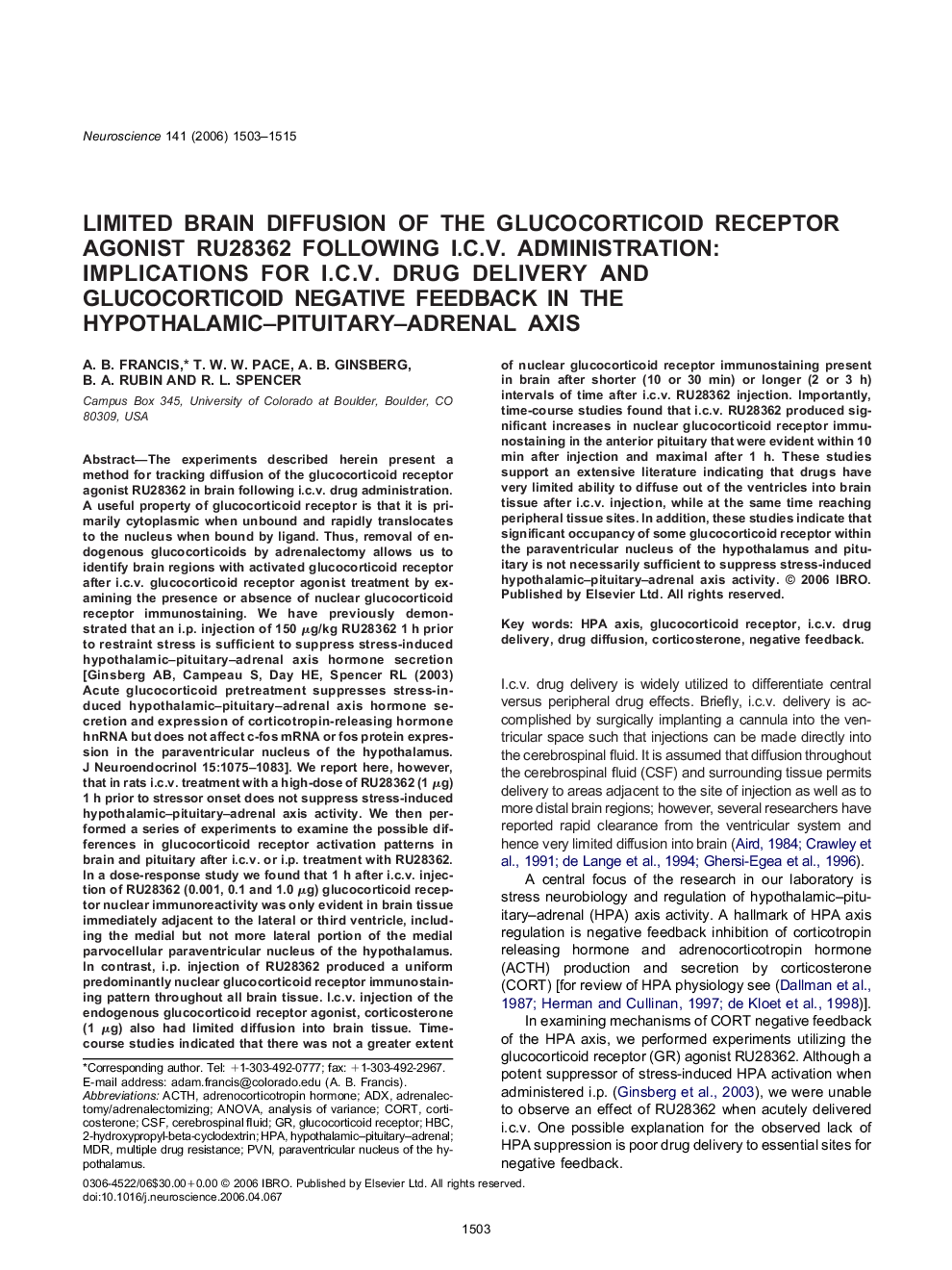| کد مقاله | کد نشریه | سال انتشار | مقاله انگلیسی | نسخه تمام متن |
|---|---|---|---|---|
| 4342553 | 1295873 | 2006 | 13 صفحه PDF | دانلود رایگان |
عنوان انگلیسی مقاله ISI
Limited brain diffusion of the glucocorticoid receptor agonist RU28362 following i.c.v. administration: Implications for i.c.v. drug delivery and glucocorticoid negative feedback in the hypothalamic-pituitary-adrenal axis
دانلود مقاله + سفارش ترجمه
دانلود مقاله ISI انگلیسی
رایگان برای ایرانیان
کلمات کلیدی
2-hydroxypropyl-beta-cyclodextrinACTHMDRHBCADXDrug diffusion - انتشار مواد مخدرnegative feedback - بازخورد منفیanalysis of variance - تحلیل واریانسANOVA - تحلیل واریانس Analysis of variancePVN - مالیات بر ارزش افزودهCSF - مایع مغزی نخاعیCerebrospinal fluid - مایع مغزی نخاعیHPA axis - محور هیپوتالاموس-هیپوفیز-آدرنالMultiple drug resistance - مقاومت دارویی چندگانهHPA - میلی بار یا هکتوپاسکالparaventricular nucleus of the hypothalamus - هسته پروانه مرکزی هیپوتالاموسadrenocorticotropin hormone - هورمون adrenocorticotropinhypothalamic–pituitary–adrenal - هیپوتالاموس-هیپوفیز-آدرنالCORT - کورتCorticosterone - کورتیکوسترونglucocorticoid receptor - گیرنده گلوکوکورتیکوئید
موضوعات مرتبط
علوم زیستی و بیوفناوری
علم عصب شناسی
علوم اعصاب (عمومی)
پیش نمایش صفحه اول مقاله

چکیده انگلیسی
The experiments described herein present a method for tracking diffusion of the glucocorticoid receptor agonist RU28362 in brain following i.c.v. drug administration. A useful property of glucocorticoid receptor is that it is primarily cytoplasmic when unbound and rapidly translocates to the nucleus when bound by ligand. Thus, removal of endogenous glucocorticoids by adrenalectomy allows us to identify brain regions with activated glucocorticoid receptor after i.c.v. glucocorticoid receptor agonist treatment by examining the presence or absence of nuclear glucocorticoid receptor immunostaining. We have previously demonstrated that an i.p. injection of 150 μg/kg RU28362 1 h prior to restraint stress is sufficient to suppress stress-induced hypothalamic-pituitary-adrenal axis hormone secretion [Ginsberg AB, Campeau S, Day HE, Spencer RL (2003) Acute glucocorticoid pretreatment suppresses stress-induced hypothalamic-pituitary-adrenal axis hormone secretion and expression of corticotropin-releasing hormone hnRNA but does not affect c-fos mRNA or fos protein expression in the paraventricular nucleus of the hypothalamus. J Neuroendocrinol 15:1075-1083]. We report here, however, that in rats i.c.v. treatment with a high-dose of RU28362 (1 μg) 1 h prior to stressor onset does not suppress stress-induced hypothalamic-pituitary-adrenal axis activity. We then performed a series of experiments to examine the possible differences in glucocorticoid receptor activation patterns in brain and pituitary after i.c.v. or i.p. treatment with RU28362. In a dose-response study we found that 1 h after i.c.v. injection of RU28362 (0.001, 0.1 and 1.0 μg) glucocorticoid receptor nuclear immunoreactivity was only evident in brain tissue immediately adjacent to the lateral or third ventricle, including the medial but not more lateral portion of the medial parvocellular paraventricular nucleus of the hypothalamus. In contrast, i.p. injection of RU28362 produced a uniform predominantly nuclear glucocorticoid receptor immunostaining pattern throughout all brain tissue. I.c.v. injection of the endogenous glucocorticoid receptor agonist, corticosterone (1 μg) also had limited diffusion into brain tissue. Time-course studies indicated that there was not a greater extent of nuclear glucocorticoid receptor immunostaining present in brain after shorter (10 or 30 min) or longer (2 or 3 h) intervals of time after i.c.v. RU28362 injection. Importantly, time-course studies found that i.c.v. RU28362 produced significant increases in nuclear glucocorticoid receptor immunostaining in the anterior pituitary that were evident within 10 min after injection and maximal after 1 h. These studies support an extensive literature indicating that drugs have very limited ability to diffuse out of the ventricles into brain tissue after i.c.v. injection, while at the same time reaching peripheral tissue sites. In addition, these studies indicate that significant occupancy of some glucocorticoid receptor within the paraventricular nucleus of the hypothalamus and pituitary is not necessarily sufficient to suppress stress-induced hypothalamic-pituitary-adrenal axis activity.
ناشر
Database: Elsevier - ScienceDirect (ساینس دایرکت)
Journal: Neuroscience - Volume 141, Issue 3, 2006, Pages 1503-1515
Journal: Neuroscience - Volume 141, Issue 3, 2006, Pages 1503-1515
نویسندگان
A.B. Francis, T.W.W. Pace, A.B. Ginsberg, B.A. Rubin, R.L. Spencer,